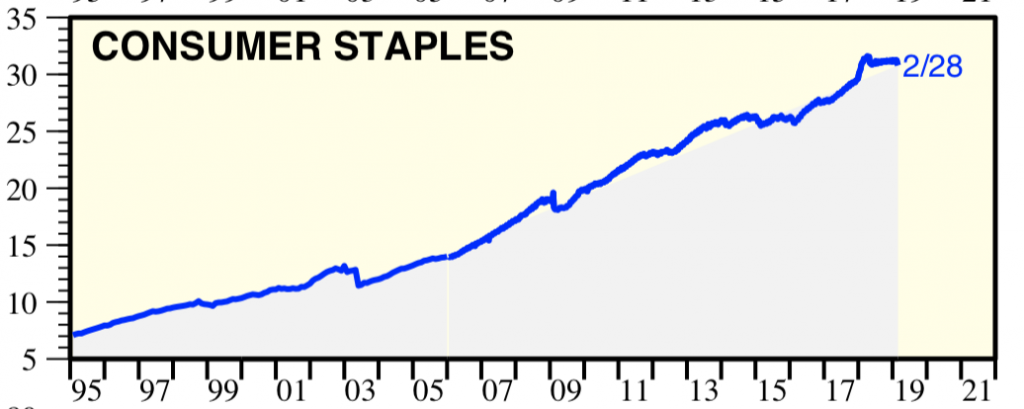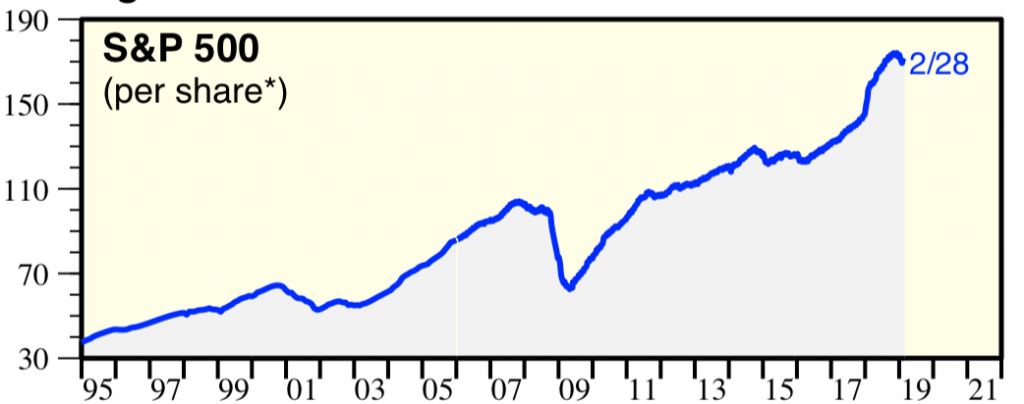Re-balance Cycle Reminder All MyPlanIQ’s newsletters are archived here.
For regular SAA and TAA portfolios, the next re-balance will be on Monday, March 18, 2019. You can also find the re-balance calendar for 2019 on ‘Dashboard‘ page once you log in.
As a reminder to expert users: advanced portfolios are still re-balanced based on their original re-balance schedules and they are not the same as those used in Strategic and Tactical Asset Allocation (SAA and TAA) portfolios of a plan.
Please note that we now list the next re-balance date on every portfolio page.
Consumer Staples Sector Review
A broad market index can be further divided into so called sectors based on a company’s industry category. For example, S&P 500 right now has the following 11 sectors:
| ETF Symbol |
Select Sector SPDR Fund |
| XLC |
Communication Services |
| XLY |
Consumer Discretionary |
| XLP |
Consumer Staples |
| XLE |
Energy |
| XLF |
Financials |
| XLV |
Health Care |
| XLI |
Industrials |
| XLB |
Materials |
| XLRE |
Real Estate |
| XLK |
Technology |
| XLU |
Utilities |
Among them, XLC is an expanded/renamed telecommunication sector that now includes Facebook, Google, Netflix and even video game companies like Electronic Arts. Also, S&P now finally includes a stand alone Real Estate sector XLRE. In fact, long term MyPlanIQ clients know that we treat Real Estate Investment Trusts (REITs) as a major asset class, not just merely a sector.
In this newsletter, we want to take a closer look at another major sector, Consumer Staples.
Consumer Staples Stocks
Let’s first look at the major stocks in this sector. The following are the top ten holdings in XLP, the consumer staples sector fund:
| Symbol |
Name |
Index Weight |
| PG |
Procter & Gamble |
14.87% |
| KO |
Coca-Cola Co |
10.61% |
| PEP |
PepsiCo Inc |
9.87% |
| WMT |
Walmart Inc. |
8.40% |
| COST |
Costco Wholesale Corp |
4.96% |
| PM |
Philip Morris International |
4.84% |
| MO |
Altria Group Inc |
4.75% |
| MDLZ |
Mondelez International Inc |
4.73% |
| CL |
Colgate-Palmolive Co |
3.94% |
| WBA |
Walgreens Boots Alliance Inc |
3.37% |
This sector includes companies that provide essential consumer products and services. It’s also called consumer defensive as these stocks usually perform better than other stocks during an economic downturn.
Unlike high growth technology or health care stocks, this sector mostly consists of steady but boring businesses. Many stock investors simply feel these are low return stocks and easily ignore them.
The following charts show the earnings growth for both S&P 500 and S&P 500 Consumer Staples since 1995:
Not only consumer staples stocks deliver slightly better earnings growth than S&P 500 in this period (95-2019), they did that with much more smooth fashion. This is reflected in their stock returns.
We compare Vanguard Consumer Staples index fund (VCSAX) with VFINX (Vanguard S&P 500 index). We have data for VCSAX since 2/4/2004.
Consumer staples vs. S&P 500 total returns (as of 3/11/2019)
So the consumer staples stocks have had a higher 15 year total returns but with 40% less maximum drawdown defined as the maximum loss from a peak to a following trough.
Unfortunately, the above data only cover last 15 years. To look at longer history, we use Fidelity Select Consumer Staples fund (FDFAX), a fund that has higher expense ratio and worse returns than VCSAX:
S&P 500 vs. Consumer Staples (Fidelity Select), as of 3/11/2019:
For more than 31 plus years, consumer staples stocks outperformed S&P 500 index by about 1.2%, a very meaningful margin. Again, they have done that with much less volatility.
The above observations are not surprising: it’s been known that stable businesses tend to deliver better returns with less risk in a long term. We also note that consumer staples tend to have low or even negative correlation with S&P 500 in some periods. For example, FDFAX lost -20.5% in 1999 (while VFINX gained 21.1% in that year). However it gained 29.8% in 2000 when the technology induced recession began (VFINX lost -9%, -12% and -22% in the three consecutive years 2000, 2001, 2002). The gain made FDFAX essentially flat from 1999 to 2002.
In conclusion, consumer staples can be an important sector (or even an asset) in asset allocation. They often are more defensive in a market downturn. As the current bull market is possibly in its final phase, we should pay more attention at this moment.
Stocks experienced the first meaningful correction last week. At the moment, REITs and bonds have done better than stocks. European economic growth slowdown now forces its central bank to stop hiking interest rate. Whether the supportive monetary policies from the U.S., EU and China will prevent the global growth slowdown remains to be seen. Again, as stocks have taken a breath from their furious ascent in a still highly over valued level, we call for staying the course and managing risk.
In terms of investments, even after the recent retreat, U.S. stock valuation is still at a historically high level and a bigger correction is still waiting to happen. It is thus not a good time to take excessive risk. However, we remain optimistic about U.S. economy in the long term and believe much better investment opportunities will arise in the future.
We again would like to stress for any new investor and new money, the best way to step into this kind of markets is through dollar cost average (DCA), i.e. invest and/or follow a model portfolio in several phases (such as 2 or 3 months) instead of the whole sum at one shot.
–Thanks to those who have already contributed — we appreciate it.
Disclaimer:
Any investment in securities including mutual funds, ETFs, closed end funds, stocks and any other securities could lose money over any period of time. All investments involve risk. Losses may exceed the principal invested. Past performance is not an indicator of future performance. There is no guarantee for future results in your investment and any other actions based on the information provided on the website including, but not limited to, strategies, portfolios, articles, performance data and results of any tools. All rights are reserved and enforced. By accessing the website, you agree not to copy and redistribute the information provided herein without the explicit consent from MyPlanIQ.




 Diversified Asset Allocation Portfolios For Your Plans
Diversified Asset Allocation Portfolios For Your Plans
